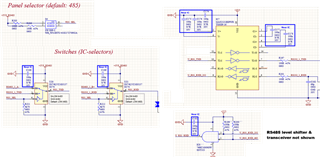Other Parts Discussed in Thread: TMUX6236
Tool/software:
Hello,
I need to connect a microcontroller to a RS232 or RS485 through the same connector (selection via dip switch).
The microcontroller is connected via a single UART port to an RS232 (MAX3232EIPWR) and an RS485 transceiver (+ an AND port to merge RXD signals on the microcontroller side).
The outputs of the two transceivers must be muxed to a single connector and I'd like to use the SN74LVC1G3157.
Voltage reference is 5V, maximum speed is 115200bps, so I don't expect any issues related to delays and the selector will be only switched while the system is off.
Do you see any potential issues in the application, in particular:
- Are ports fully bidirectional (i.e. either A or B is driving the line HIGH/LOW)?
- Should I expect any OFF- current flow between A and the unconnected port in either direction, when A=5V and B=0V or vice versa (some sort of bulk diode conduction, besides the OFF-state switch leakage current as per Section 6.5 of the datasheet)?
Thanks for your support.
Kind regards,
Stefano


